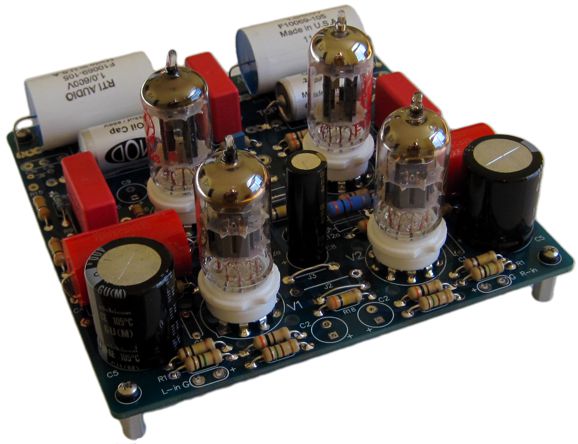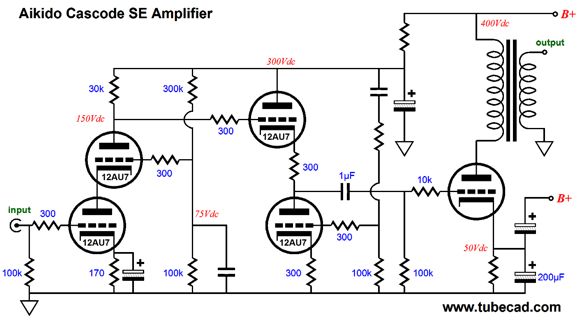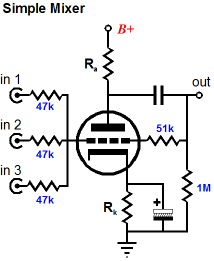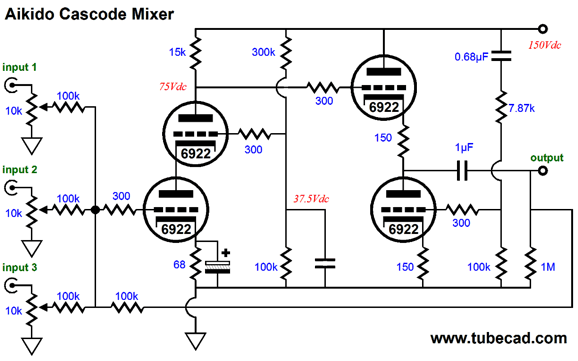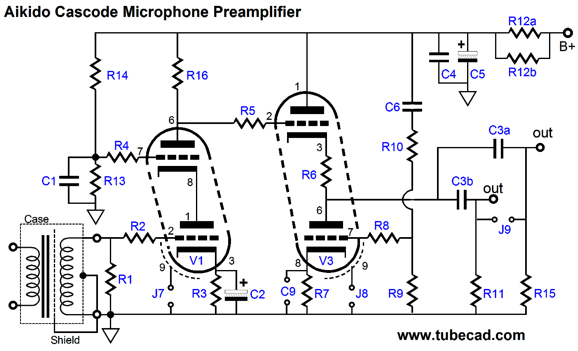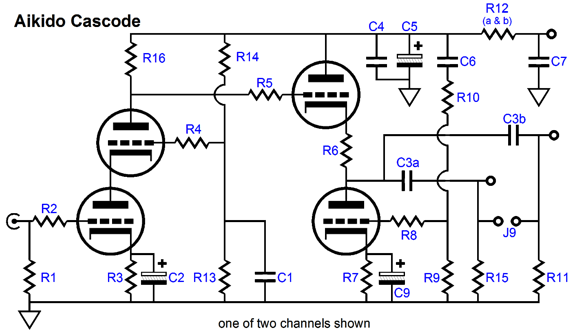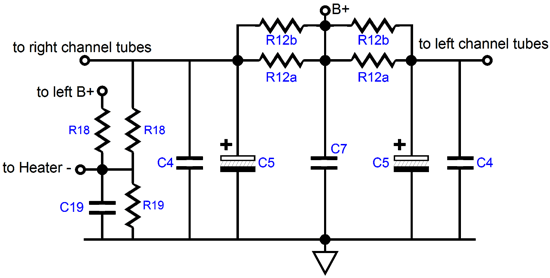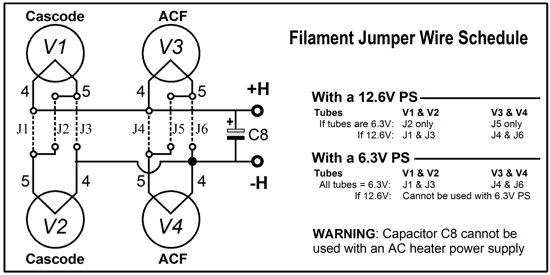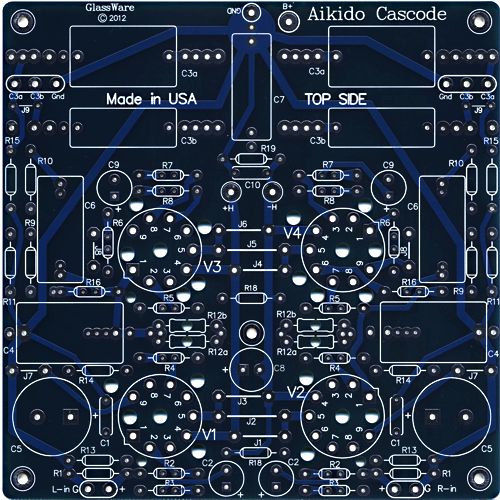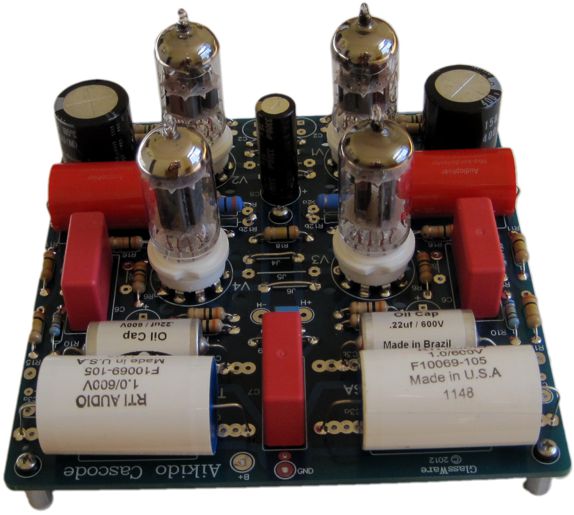| John Broskie's Guide to Tube Circuit Analysis & Design |
|
Post 248 31 October 2012
Happy Halloween! My parents used to give quarters instead of candy. They had read that many parents threw away suspect candy, which my parents thought wasteful, so money was substituted. Well, I know what as a kid I would have liked to find in my bag: resistors, capacitors, and tubes. (Actually, there was a sweet old German lady in my neighborhood who made the most delicious oatmeal cookies that I have ever eaten. I would look forward every Halloween to receiving my bag of cookies. The queer thing was that her silverware bore small red swastikas! Perhaps, she was deeply into Ancient Hinduism, as in Sanskrit svastikah is the sign of good luck, which comes from from svasti, which means well-being? But then, possibly Hitler and certainly Himmler were deeply into Ancient Hinduism...)
Aikido Cascode
Aikido Cascode SE Amplifier
The 12AU7 delivers a gain of about 50 in above cascode input stage, which is enough to the drive the output tube to full output. If even more gain were required, say to drive an 845 transmitting tube to full output, then a 6DJ8/6922/E88CC would do the job. Just imagine a chassis with four noval tube in the center, flanked by 300Bs. At the other extreme, if a unity-gain, inverting, negative-feedback-based circuit is needed, then the Aikido Cascode's high gain and low Miller-effect capacitance would prove adventitious. For example, a tube-based mixer could be made easily enough.
Aikido Cascode Mixer
A tube mixer can be made from a single triode, as the schematic above shows. Such a simple circuit works surprisingly well. But there are few design issues with this simple mixer; for example, the Miller-effect capacitance is effectively in parallel with the 51k feedback resistor. In addition, the summing node at the grid will be quite high in impedance, whereas we desire a very low impedance at this node. Making a world-glass ( ;} ) tube mixer requires a bit more effort.
The above Aikido Cascode tube-based mixer accepts each of its three input signals via a 100k resistor, which finds it match in a 100k NFB resistor. The result is that the mixer delivers a gain of unity, 1V in, 1V out. At the same time, the high negative feedback ensures that the nexus of all four 100k resistors is very low in impedance, only about 1kohms, which means that very little signal bleed-through between input signals occurs. Speaking of low impedances, the output impedance of the above mixer is only around 5 ohms, which for an entirely-tube-based circuit is amazingly low. In addition, the PSRR and THD are supremely fine. Note the low 150Vdc B+ voltage. Of course, a higher voltage could be used, say 300Vdc, but the advantage of running a B+ lower than 200Vdc is that 200V power-supply capacitors can be used, which are much more volumetrically efficient than 400Vdc capacitors. The advantage of running a 300Vdc B+ voltage is that much more open-loop signal gain can be realized, which will power the negative feedback loop, thereby further lowering the Zo and distortion.
Aikido Microphone Preamp A 6DJ8-based Aikido Cascode stage will yield a gain of about +44dB (x166), which might prove sufficient. If more gain is required, say +60dB, then a step-up transformer must make up the difference. For example, a transformer winding ratio of 1:6 equals +16dB, as dB gain = 20 x log(gain). This gain is added to the Aikido Cascode's +44dB to make a total of +60dB. (Depending on the microphone, this might be too little or too much gain.) Moreover, the transformer can readily accept a balanced input signal and break ground loops and eliminate the need for input coupling capacitors.
High transconductance input tubes are best for low-noise, high gain, for example the 6DJ8, 6N1P, and ECC99. But for many audiophiles, the only tubes worth bothering with all begin with “12A” and end with “7.” For such individuals, the 12AX7 & 12AU7 combination will realize a gain of 200 (+46dB), but the 12AX7 cannot compete in a low-noise race with the previously listed tubes.
Aikido Cathode Follower
This formula assumes a bypassed cathode resistor. If Rk is unbypassed, then the following formula is needed.
Then we use the following formula to set top resistor R10 relative to the bottom resistor R9 in the two-resistor voltage-divider.
Okay, I know that many readers are breaking out in cold sweats right now, but trust me: it's not nearly as scary as it looks. In fact, learn to have fun with algebra and tube circuits. As soon as I see a formula, like the one above, I instantly throw in two extreme cases to see what happens, for example, no power-supply noise (a ratio of zero) and all the noise (a ratio of 1.0). If no power-supply noise is presented to the Aikido cathode follower's input, then the top resistor must equal (µ - 1)Rbottom, which will provide just enough power-supply noise to be injected into the bottom triode's grid to counter the power-supply noise present at the top triode's plate. If all of the power-supply noise is presented to the Aikido cathode follower's input, then no value can be set for the top resistor, as it would require a negative resistance. The workaround would be to just replace the top resistor with a jumper wire and live with the tiny amount of noise that cannot be nulled away. (A better workaround would be to use the jumper and make cathode resistor R6 a tad larger than R7, but this requires some tweaking of values.)
New Aikido Cascode PCB
This PCB is not an All-in-One effort. In fact, I am moving away from such designs. Why? So many customers want to use a different power supply. Some want a tube rectifier, such as the Janus, PS-4, and PS-5 use. Others want a fully regulated power supply, such as the PS-1. Others still want to use AC on the heaters and tap off an existing B+ connection. By leaving the power supply off the Aikido Cascode, all these customers can be made happy. At the same, the Aikido Cascode holds a large RC power-supply filter per channel, as the schematic below shows.
The input tube and output tube heaters can be wired either in series or in parallel.
Note the dual output capacitors, which can be used individually or in parallel (use jumper J9). I love this feature, as it bestows some needed sonic control over my music reproduction. In fact, I can not imagine living without it. Some recordings cry out for a PIO coupling capacitors, others don't. It is wonderful to have the choice. The list of possible tubes that can be used with this PCB is a long one: 6AQ8, 6BC8, 6BK7, 6BQ7, 6BS8, 6DJ8, 6FQ7, 6GC7, 6H30, 6KN8, 6N1P, 12AT7, 12AU7, 12AV7, 12AX7, 12BH7, 12DJ8, 12FQ7, 5751, 5963, 5965, 6072, 6922, E188CC, ECC88, ECC99… The only stipulations are that the two triodes within the envelope be similar and that the tube conforms to the 9A or 9AJ base pin-out.
The Aikido Cascode PCB and kits are now available at the GlassWare Yahoo store. If you have need for a lot of tube-based gain, this is an easy and inexpensive ($36 for the PCB and user guide) way to acquire it.
Next Time
//JRB
|
|
I know that some readers wish to avoid Patreon, so here is a PayPal button instead. Thanks.
John Broskie
Only $12.95 TCJ My-Stock DB
Version 2 Improvements *User definable Download or CD ROM www.glass-ware.com |
||
| www.tubecad.com Copyright © 1999-2012 GlassWare All Rights Reserved |


